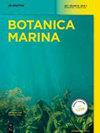Seasonal and culture period variations in the lipid and fatty acid content of Ulva lactuca cultivated in Mikhmoret onshore (Israel)
IF 1.4
4区 生物学
Q2 MARINE & FRESHWATER BIOLOGY
引用次数: 0
Abstract
The use of high-value fatty acids (FA), omega-3 (Mikhmoret 沿岸(以色列)养殖的乳莼脂质和脂肪酸含量的季节和养殖期变化
利用海藻中的高价值脂肪酸(FA)、ω-3(n-3)和ω-6(n-6)可以缓解天然野生鱼类资源的压力,减少全球范围内的过度捕捞。本研究旨在探讨收获季节(冬季、春季和夏季)和养殖期如何影响绿色海藻莼菜(Ulva sp)的生物量产量、脂质含量和脂肪酸组成。所研究的海藻于 2019 年 7 月至 2020 年 12 月在 Mikhmoret(以色列东地中海)的塑料套管中用流动海水养殖。通过使用 rbcL、ITS 和 tufA 标记进行 DNA 条形编码,确定莼菜物种为林尼厄斯乳莼(Ulva lactuca Linnaeus)。在整个研究期间,未发现乳莼样本中存在可检测到的遗传变异。在不同收获季节对乳莼菜中的脂质和脂肪酸含量进行的定量检测显示,夏季脂质含量最高,冬季多不饱和脂肪酸(PUFA)含量最高。多不饱和脂肪酸包括二十碳五烯酸、二十二碳五烯酸、二十二碳六烯酸、n-3 和 n-6,其中 n-6/n-3 的比例与均衡营养膳食的理想范围相当。
本文章由计算机程序翻译,如有差异,请以英文原文为准。
求助全文
约1分钟内获得全文
求助全文
来源期刊

Botanica Marina
生物-海洋与淡水生物学
CiteScore
4.10
自引率
4.50%
发文量
43
期刊介绍:
Botanica Marina publishes high-quality contributions from all of the disciplines of marine botany at all levels of biological organisation from subcellular to ecosystem: chemistry and applications, genomics, physiology and ecology, phylogeny and biogeography. Research involving global or interdisciplinary interest is especially welcome. Applied science papers are appreciated, particularly when they illustrate the application of emerging conceptual issues or promote developing technologies. The journal invites state-of-the art reviews dealing with recent developments in marine botany.
 求助内容:
求助内容: 应助结果提醒方式:
应助结果提醒方式:


